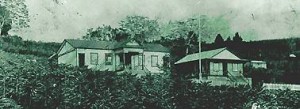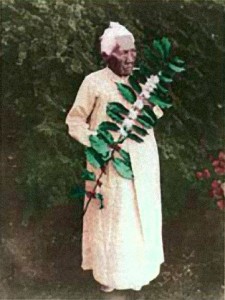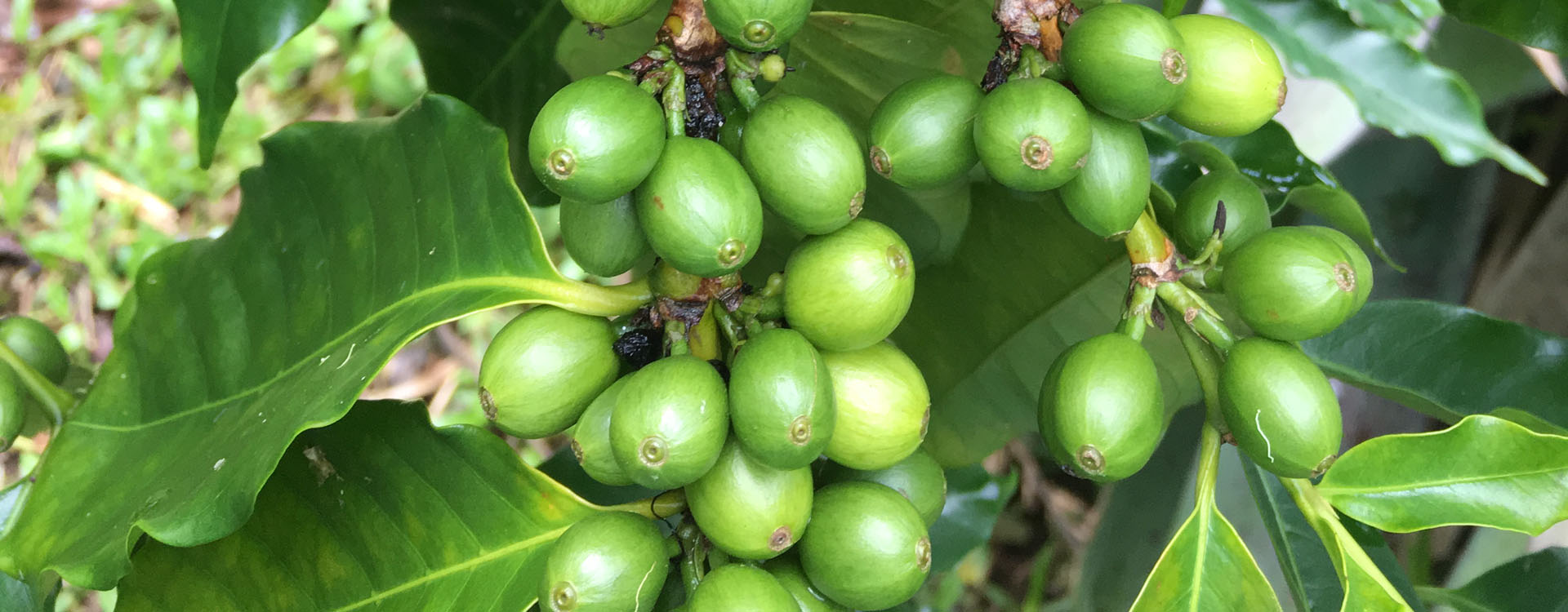Do you encourage visitors?
No and for a couple of reasons. We do not have a store front- this is our house. It is just Bob and me, so we are not set-up for visitors. We live 2 miles up a semi-paved, one lane private, 4 Wheel drive road. But don't be discouraged, there are many farms that want visitors. Go here http://www.konacoffeefarmers.org/farmTours.asp and you'll find over 40 farms that would love to have you. (I am
Total Satisfaction is our AIM!
While we guarantee satisfaction, please check the email I send via stamps.com for your package's tracking purposes. That guarantees that it was sent it but the length of time is a little variable and all up to the USPS.
Smithfarms Coffee Prices
COFFEE COFFEE 100% Pure Kona “Estate Grade” Roasted Coffee * Whole Beans $37/LB + $9.5 S&H via USPS $19.50/Half LB + $9.5 S&H via USPS $180/FIVE LB Bulk bag + $16.00 S&H via USPS 100% Pure Kona “Estate Grade” Roasted Coffee *Ground Beans $38/LB + $9.5 S&H via USPS $20.50/HALF LB + $9.5 S&H via USPS
Ordering and Shipping
To order please go here: https://www.smithfarms.com/order/ Shipping Information below. All USPS mail will be handled by Stamps.com, their sub-contractor Please look for an email from stamps.com which will let you know your order has shipped. (CHECK YOUR SPAM folder!) Thanks. #1) USPS Tracking is not totally exact. I hand in the package here in Honaunau on Hawaii island about 8 am. The package then goes to Honolulu on Oahu island. Sometimes it lingers there for no
LA Times article from September 15, 2019
wholly unexpected WOW! click to read>>>> Los Angeles Times - 9.15.2019
Are You Organic?
Here's an article and we share the feelings. read here> http://tinyurl.com/h6699s2 No. There is no organic source of fertiliser in Hawaii. All fertiliser organic or otherwise, needs to be shipped in. This of course increases prices dramatically and we could not afford to apply the adequate amounts of organic nutrition to our coffee trees that they need to remain vigorous, without pricing our coffee to the extreme and frankly, we could not make a
2022-2023 Crop Report
HPR The Conversation- with Kona Coffee Farmers' President Suzanne Shriner Local coffee farmers brace for yields up to 40% lower than usual Audio: https://www.hawaiipublicradio.org/the-conversation/2022-09-13/local-coffee-farmers-brace-for-yields-up-to-40-lower-than-usual Hawaii Public Radio | By Catherine Cruz Published September 13, 2022 at 4:27 PM HST The Kona Coffee Farmers Association says the Hawaiʻi coffee industry is bracing for what could be one of their worst years for production. That will likely mean higher prices for coffee drinkers as well. On Hawaiʻi Island, some farmers say their crop yields are
The Kona Tradition- by C. B.Smith
 The Kona Tradition by C. B. Smith-
(written originally in 1999 and edited in 2023 ---much remains the same in 2023, except for the invasive pests, irresponsibly brought to Hawaii in the last few years. We believe the importation of green beans to Hawaii from other areas caused the problem.---Copyright of Cecelia Burns Smith)
Another day begins for the Kona coffee farmer. While cardinals start their song and morning breezes flow down from Mauna Loa (elevation 13,333 feet), the farmer grabs a cup of his best brew and walks out the door into history.
Kona coffee refers to coffee that is grown only in the North and South Districts of Kona on Hawaii island . These Kona Districts cover an area of about 20 miles long and 2 miles wide, on the west coast of the island. The North Kona area is on the slopes of Mt. Hualalai, while South Kona is on the slopes of Mauna Loa.
At last count, there were fewer than 600 farms growing coffee in the Kona Districts. While there are several farms over 65 acres each, the majority are much smaller and average about 5 acres. Only these farms produce Kona coffee. Coffee that is grown on other parts of the island or on other islands within the Hawaiian Chain may not call their product Kona coffee.
Kona Coffee, a Coffea arabica -var. typica, is generally acknowledged as one of the two most highly valued coffees in the world and it was first brought, in 1829, to Hawaii island by missionary and teacher Samuel Ruggles.
According to "Cup of Aloha" by well respected Kona Coffee authority, Gerald Kinro- published by University of Hawai'i Press in 2003-, Chapter 1, page 8... "Don Francisco de Paula Marin---- Chilean Counsel and provisioner of ships, Kamehameha I's interpreter and physician and distiller---- planted the first coffee seeds in Hawai'i in 1817...and coffee did not become established. "
On an about to be fateful voyage in 1823.." Kamehameha II (Liholiho)and his wife Kamamalu, departed for England...with Chief Boki. governor of O'ahu." Liholiho and wife died.....and "Boki enjoyed coffee houses and 'seeing the potential for coffee to grow in Hawai'i' , Boki stopped in Brazil and bought coffee seedlings."
"Wilkinson (Boki's English agriculturist) efforts were more fruitful than Marin's and he successfully established a coffee orchard..in Manoa.
The Kona Tradition by C. B. Smith-
(written originally in 1999 and edited in 2023 ---much remains the same in 2023, except for the invasive pests, irresponsibly brought to Hawaii in the last few years. We believe the importation of green beans to Hawaii from other areas caused the problem.---Copyright of Cecelia Burns Smith)
Another day begins for the Kona coffee farmer. While cardinals start their song and morning breezes flow down from Mauna Loa (elevation 13,333 feet), the farmer grabs a cup of his best brew and walks out the door into history.
Kona coffee refers to coffee that is grown only in the North and South Districts of Kona on Hawaii island . These Kona Districts cover an area of about 20 miles long and 2 miles wide, on the west coast of the island. The North Kona area is on the slopes of Mt. Hualalai, while South Kona is on the slopes of Mauna Loa.
At last count, there were fewer than 600 farms growing coffee in the Kona Districts. While there are several farms over 65 acres each, the majority are much smaller and average about 5 acres. Only these farms produce Kona coffee. Coffee that is grown on other parts of the island or on other islands within the Hawaiian Chain may not call their product Kona coffee.
Kona Coffee, a Coffea arabica -var. typica, is generally acknowledged as one of the two most highly valued coffees in the world and it was first brought, in 1829, to Hawaii island by missionary and teacher Samuel Ruggles.
According to "Cup of Aloha" by well respected Kona Coffee authority, Gerald Kinro- published by University of Hawai'i Press in 2003-, Chapter 1, page 8... "Don Francisco de Paula Marin---- Chilean Counsel and provisioner of ships, Kamehameha I's interpreter and physician and distiller---- planted the first coffee seeds in Hawai'i in 1817...and coffee did not become established. "
On an about to be fateful voyage in 1823.." Kamehameha II (Liholiho)and his wife Kamamalu, departed for England...with Chief Boki. governor of O'ahu." Liholiho and wife died.....and "Boki enjoyed coffee houses and 'seeing the potential for coffee to grow in Hawai'i' , Boki stopped in Brazil and bought coffee seedlings."
"Wilkinson (Boki's English agriculturist) efforts were more fruitful than Marin's and he successfully established a coffee orchard..in Manoa.
 Coffee immediately thrived in the optimum weather pattern of mauka Kona, where sunny mornings and an afternoon cloud cover continue to be the norm. Kona’s wet summer and dry winter is the exact climate the Coffea arabica plant prefers.
Initially, coffee was simply consumed locally or sold to passing whaling ships. In 1845 the first exports to California began an industry! The early years of the Kona Coffee market were exciting. Farmers were encouraged by landowners to begin coffee farms, although some early land leases to the farmers, demanded as much as half the crop in payment.
In 1900 however, the final tariff for sugar cane shipped from Hawaii to the United States was removed, and the development of new sugar cane lands was enthusiastically encouraged by Territory of Hawaii administrators. Coffee was quickly relegated to a secondary position and some acreage was even plowed under.
Although the original farmers in 1893 were Japanese contract coffee laborers brought directly from Japan to work coffee, no coffee plantation begun in the late 1890s was financially successful.
(Ed. note- Fascinating Oral History done in 1980 here: https://imagesofoldhawaii.com/social-history-of-kona/ )
Coffee immediately thrived in the optimum weather pattern of mauka Kona, where sunny mornings and an afternoon cloud cover continue to be the norm. Kona’s wet summer and dry winter is the exact climate the Coffea arabica plant prefers.
Initially, coffee was simply consumed locally or sold to passing whaling ships. In 1845 the first exports to California began an industry! The early years of the Kona Coffee market were exciting. Farmers were encouraged by landowners to begin coffee farms, although some early land leases to the farmers, demanded as much as half the crop in payment.
In 1900 however, the final tariff for sugar cane shipped from Hawaii to the United States was removed, and the development of new sugar cane lands was enthusiastically encouraged by Territory of Hawaii administrators. Coffee was quickly relegated to a secondary position and some acreage was even plowed under.
Although the original farmers in 1893 were Japanese contract coffee laborers brought directly from Japan to work coffee, no coffee plantation begun in the late 1890s was financially successful.
(Ed. note- Fascinating Oral History done in 1980 here: https://imagesofoldhawaii.com/social-history-of-kona/ )
1955 Lava Flow and we were there:)
My dad Frank Burns (CES Burns Jr.) took most of this video. He was manager and had to prove to the insurance company that the fire destroyed the cane acreage-----before the approaching lava. The sugar plantation had insurance for fire- not lava- and lots of acreage was burned. All we Burns kids are in the video, mom and dad, even our grandmother Puna Walker and our parents good friends David and Beppy
Sea Grapes
excerpt taken from Marie C. Neal's IN GARDENS OF HAWAII- 1965 Coccoloba uvifera: (the entire section below) At home in thickets along sandy shores in warm parts of America is the sea grape,which in Hawaii is planted as a windbreak near beaches. It is a twisting tree, to 20 feet or more high; the trunk rarely attains a diameter of 3 feet. The branches zig zag and form a dense canopy;

